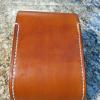-
Content Count
69 -
Joined
-
Last visited
-
if you're going for hand stitching, consider getting either a "stitching Chisel" or "Pricking Iron", they make good uniform holes that'll make it easier to stitch. An awl will be good to have too..
-
AdamGadut started following Burnishing Problem Solved - Motorized on the Cheap, leather and sewing machine questions, What leather would you use for a leather watch strap? and and 5 others
-
in some ways yes. For one, the stitch wont easily unravel unlike the locked stitch in case there's a broken link. another better thing here is that, you will be able to stitch ANY thickness. The only downside is that, its many many times slower and takes some patience. You probably wont need to stitch a lot since likely the thickness of the hide will be enough in one layer for a tooled belt - that unless you want it in 2 layers. that sewing machine you have, is it a walking foot?... if yes, then it should be able to stitch most thickness you need for a leather belt.
-
.thumb.jpg.b00f1d0635f260ee9e5b9aa4b3eb1080.jpg)
What leather would you use for a leather watch strap?
AdamGadut replied to JPUK100's topic in Leatherwork Conversation
something that's preferably thin so you can do the refined ones with folds, unless you are aiming for the simple straps goat hide - quick and easy - good for the straps with linings inside so they raise up other leathers should be ok as long as they are vegetanned, and that if you can skyve evenly -
Chrome tanned leathers are too soft and pliable, they never retain any shape. Hardly even retains stamp marks.
-
.thumb.jpg.b00f1d0635f260ee9e5b9aa4b3eb1080.jpg)
Shoemaking! [first ever shoe I made]
AdamGadut replied to AdamGadut's topic in Shoes, Boots, Sandals and Moccassins
@MichaelIT , if you can make leather goods, then you should be able to make this its just worth a try.. - one of those things you can really be proud of when you finally something in your hand thats finished. I have some more ideas i really really wanna have the real finished item in my hand. I believe you also have some ideas what combination of colors should a shoe have. @WoodysWorkshop thanks wasnt too difficult to get the two on the same size. thanks to the shoe last. The hard parts for me were 1.) the reduction in the size of the shoe last, her foot was about 1.5 CM shorter than the last but has the same width and girth, - that we did test using a mock up shoe. Since its a very curvy object, it was difficult to match the last when i was reducing the heel. and it ended up being the right side was about 3mm longer than the left. but she still liked the fit so i guess no issues there. 2.) the lasting - I had to use a technique recommended by George Koleff. was seriosly difficult to stitch when i reached the toe part. 3.) matching the patterns when i was closing the upper. the other side slightly offset from the other 4.) preparing my tools. imagine since i couldn't buy the tools online, i literally prepared my own lasting pliers and a hammer (welded, filed, and grind into shape). one tool i wasnt successful in preparing was the awl. what i created either kept breaking or was too large to be useable enough. @ryankim3612 if there's anything i can tell you, its definitely that, give it a try. First look at what you have, and be sure to be aware every step needed to complete it. - like all the details - really important, if you miss one thing, scour the web. then go give it a shot.- 12 replies
-
- cordwainer
- shoemaking
-
(and 1 more)
Tagged with:
-
.thumb.jpg.b00f1d0635f260ee9e5b9aa4b3eb1080.jpg)
Shoemaking! [first ever shoe I made]
AdamGadut replied to AdamGadut's topic in Shoes, Boots, Sandals and Moccassins
thanks i must state, since i am very used to stitching using pricking irons, and not so much with an Awl, there's definitely a different kind of difficulty added.- 12 replies
-
- cordwainer
- shoemaking
-
(and 1 more)
Tagged with:
-
.thumb.jpg.b00f1d0635f260ee9e5b9aa4b3eb1080.jpg)
Shoemaking! [first ever shoe I made]
AdamGadut replied to AdamGadut's topic in Shoes, Boots, Sandals and Moccassins
thanks man ... i believe i've read somewhere cobblers only fix shoes, cordwainer are the ones who makes shoes.- 12 replies
-
- cordwainer
- shoemaking
-
(and 1 more)
Tagged with:
-
This took me several months to get started with so many many delays and a multitude of reasons. I Seriously wanted to learn how to make shoes. The very sad truth is that, there's no school around my region that teaches this, and the only two craftsman i know who makes shoes well, one of them closed his shop and is gone, the other man is about to close his shop and is not willing to teach. So i had to learn everything that is reachable from the web. The problem with this is that, not everyone tells you what you need to know, and me being so ardent jumped straight into buying the only shoe last i could find. the seller had no idea about the lasts and she thought the last was ok for me. What she didn't know is that the last is for a female shoe. But then i happened to have a girlfriend and i was needing to give her a gift. I then thought of making her shoes. This is my output. the entire shoe is handmade - handstitched and without anyone to teach me, i steered a little bit away from the orthodox methods. I dont know if its typical for womens shoes to use the goodyear welt, and since i wanted it made in a way that it wouldn't make her foot look wide. So i did the stitching like that of the Blake welt - done my hand. there's a lot to be desired on this first build. some uneven parts on the shoe and some parts which could have been done better. these will have its own laces when she starts wearing these. She selected the design from the internet and we changed it a bit with the choice of leather. Sadly I couldn't put any more linings on it since the suede is thick. and i had to put a toe stiffener on. If anyone wants to see how i got to this point, please do say so. i have some more pictures
- 12 replies
-
- cordwainer
- shoemaking
-
(and 1 more)
Tagged with:
-
i think i'm gona give this a go. That flat bed certainly gives me an idea for a DIY, the machine can become a flatbed anytime.
-
its sad i'll never get to afford that machine.
-
a link?... not sure what brand that machine is...
-
This will be my first walking foot sewing machine if the Almighty allows it that I own one. I don't really have a lot of choices - budget constraints and availability. So I only have two choices - its either the Chinese Shoe Patcher, or the Juki model 273. Both are walking foot, One is electric and with a flat bed, the other is manual, but is very versatile with the angles it can reach. I will possibly be using this on some bags, wallets, purses, book covers, potentially belts, rare chance for holsters, - that kinda line of items. The last satchel I made reached about 6 layers on some of its parts with some upholstery leather, but typically just about 3 layers on the majority of the sewing done. The Juki 273 is appealing - the seller isn't too far from where I am located so he's readily available in case I have issues, I believe he has some parts for this machine too... but its a flat bed... It has a top and Bottom feed, the Manual for it is here: https://www.juki.co.jp/industrial_e/products_e/leather_e/cat94/tnu243_tu273.html and https://www.juki.co.jp/industrial_e/download_e/catalog_e/tu273_tnu243.pdf The Chinese patcher is appealing too in a way that its very very flexible on the angles it can reach. I imagine if i'm making a messenger bag inspired by the modern designs of today, this machine will favor a lot the hard to reach places that's almost impossible for a flat bed to do. I know the machine will come clunky and it will probably need more tuning and refining - I don't mind doing that, I'm in harmony with making my tools work for me as long as it wont require me to fabricate a complicated spare part that'll need some hundred pound machinery. slight modifications are ok with me and there's a lot of youtube videos showing how everyone made theirs work. The only downside of this is that I'll have to buy it online, I won't have aftermarket support since I'm pretty far from where I'll get it. From where I'll get these machines, the Shipping plus the price of the Chinese shoe patcher will be almost equivalent to that of the Juki 273 plus shipping. So they both have the same weight for me on this aspect. I'm just a little torn which to pick... Which would you recommend? and Why?
-
.thumb.jpg.b00f1d0635f260ee9e5b9aa4b3eb1080.jpg)
Mystery tool? Looks like an ice pick? Help...
AdamGadut replied to ELeBlanc's topic in Leatherwork Conversation
looked like a handle for something -
.thumb.jpg.b00f1d0635f260ee9e5b9aa4b3eb1080.jpg)
Burnishing Problem Solved - Motorized on the Cheap
AdamGadut replied to cjartist's topic in Leather Machinery
you may want a burnishing wheel with more varieties in the thickness it can burnish - maybe 5 in one burnisher. Two is ok if that covers everything you do though.- 21 replies
-
- burnisher
- burnishing
-
(and 1 more)
Tagged with:


